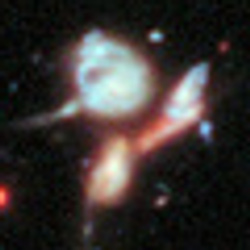Astronomers have discovered that the nearest star to the Earth, Alpha Centauri, has an exoplanet only slightly heavier than the Earth.
Big news: Astronomers have discovered that the nearest star to the Earth, Alpha Centauri, has an exoplanet only slightly heavier than the Earth.
Alpha Centauri is actually a triple star system, with two sunlike stars in a tight orbit around each other and a third star far out orbiting them both. The exoplanet orbits one of the inner stars every 3.2 days.
More details from Nature here.
Big news: Astronomers have discovered that the nearest star to the Earth, Alpha Centauri, has an exoplanet only slightly heavier than the Earth.
Alpha Centauri is actually a triple star system, with two sunlike stars in a tight orbit around each other and a third star far out orbiting them both. The exoplanet orbits one of the inner stars every 3.2 days.
More details from Nature here.

